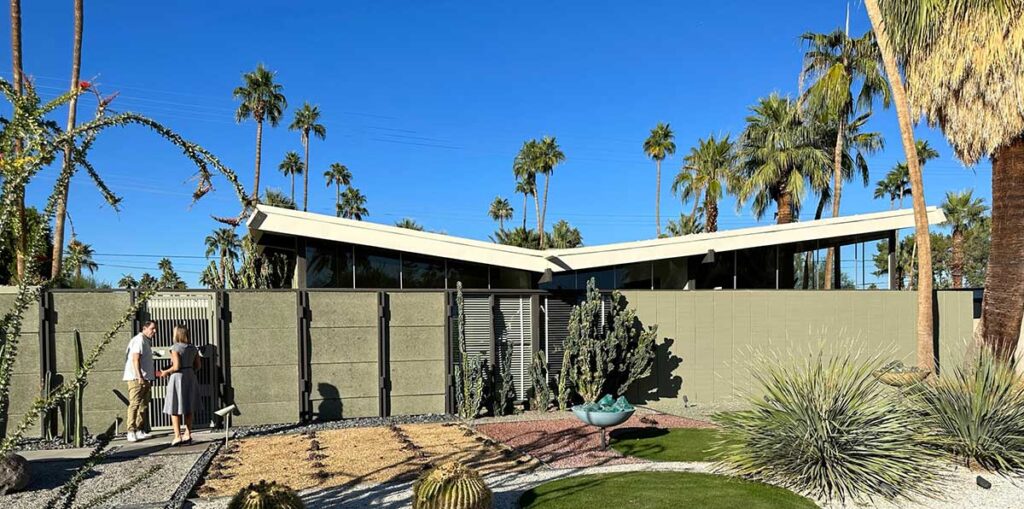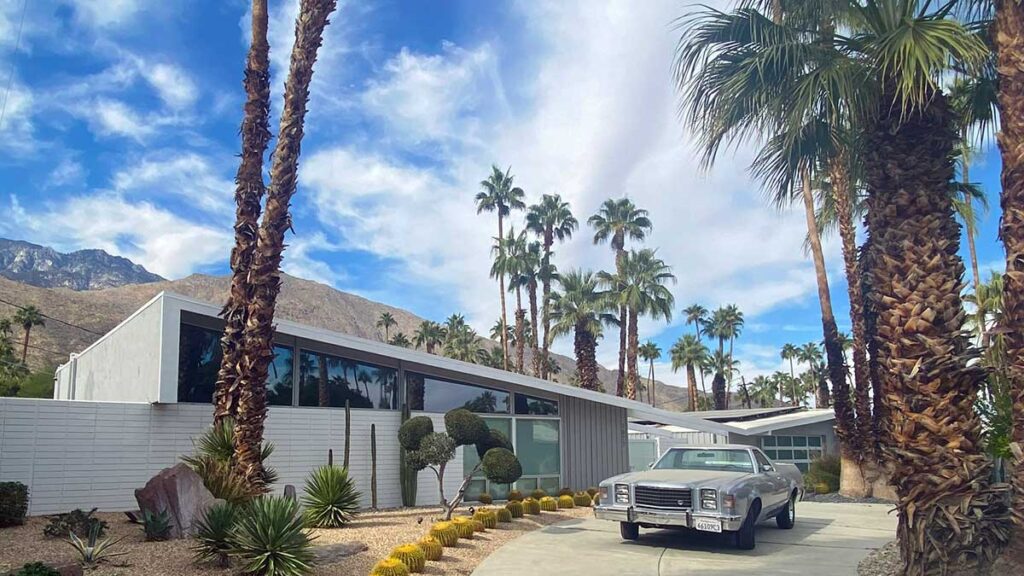How Palm Springs became synonymous with this innovative architectural style.
In the post-World War II era, a housing revolution took place that would shape the global suburban landscape for decades to come. This began in Palm Springs, a small desert town in the Coachella Valley 2.5 hours drive east of LA. Situated on the valley floor above a vast reservoir of underground water, the town is a true oasis in the desert, deriving its name from the native palm trees that form a year-round lush green canopy over the settlement.
Several Californian architects including William Krisel and Donald Wexler played pivotal roles in the transformation of this small settlement into a thriving resort town. Working with astute property developers they created new neighbourhoods filled with innovative tract housing, a type of development featuring houses that are of a similar appearance or design.
These Architects mastered the use of low-cost materials, modularization, and the deployment of different facade treatments to the same floor plan. This created a range of efficient architecturally appealing house designs that could be sited differently on individual allotments avoiding obvious replication and ensuring a dynamic streetscape.
This architectural movement came to be known as mid-century modernism, and is characterized by clean lines, open plan living, and a harmonious blend of indoor and outdoor elements.

Affordable Luxury: Low-Cost Materials
At the heart of mid-century modern tract housing was the notion of making good design accessible to the masses. Krisel and Wexler were acutely aware of the economic constraints faced by post-war families, and they embraced the challenge of creating homes that were both aesthetically pleasing and economically viable. One of their most notable contributions was the use of low-cost materials that did not compromise on quality or style.
Plywood, glass, blockwork, and steel were staples in their designs. Plywood became a signature material for its affordability and versatility. These architects harnessed the natural beauty of wood, showcasing its warmth and creating a sense of continuity between indoor and outdoor spaces.
Extensive use of glass is a common feature of mid-century modernist housing
Planning constraints adopted by the local municipality limiting the building height in residential neighbourhoods to single storey ensured privacy and maximised distant views. The use of large floor to ceiling glass windows opening into private courtyards with high level clerestory glazing not only invited ample natural light into the home, but also promoted views beyond the property to the canopies of palm trees and surrounding mountains.
Modularization: Efficiency and Flexibility
Krisel and Wexler were pioneers in the application of modular design principles to tract housing. Modularization involved creating standardized components and room modules (kitchens and bathrooms) that could be easily mass-produced and assembled, resulting in cost savings and increased efficiency. This approach allowed for the rapid construction of homes, meeting the high demand for housing in the post-war era.
A Donald Wexler prefabricated house.
The architects applied modular principles not only to the construction process but also to the design of the homes themselves. They developed a set of flexible floor plans that could be adapted to various lot sizes and orientations. This modular approach provided a level of customization for homeowners while maintaining a cost-effective and efficient building process. The result was a harmonious balance between standardized efficiency and individual expression.
William Krisel’s varied façade treatments applied to a uniform floor plan
Different Facade Treatments: Personalization and Variety
While modularization provided efficiency, Krisel and Wexler recognized the importance of individuality in creating a sense of home. To address this, they ingeniously employed different roof profiles and facade treatments for homes that shared the same core floor plan. By varying the exterior design elements, such as rooflines, entryways, materials, colours and landscaping, they added a layer of personalization and variety to the tract housing developments that hadn’t been done before.
This approach not only enhanced the aesthetic appeal of the neighbourhoods but also allowed homeowners to express their unique tastes within the confines of a standardized floor plan. The architects demonstrated that thoughtful design could transcend the uniformity often associated with tract housing, creating communities that were visually dynamic and engaging.
Legacy and Contemporary Influence
The legacy of William Krisel and Donald Wexler lives on in the enduring appeal of the mid-century modern tract housing synonymous with Palm Springs. Their innovative use of low-cost materials, modularization, and diverse facade treatments set a precedent for contemporary architects and homeowners alike. Today, mid-century modern design continues to be celebrated for its timeless elegance and practical efficiency.
You might also be interested in...
Bushfire Protection Measures for Residential Design in Australia
Drawing lessons from recent Los Angeles wildfires and Australia’s own “black summer” experience, bushfire-resistant design has become crucial for Australian homeowners, emphasising the need for fire-resistant materials, strategic landscaping, and technological solutions to protect homes in increasingly fire-prone regions.
The Latest Trends In Swimming Pool Design
Discover why smaller plunge pools are becoming Australia’s preferred choice in 2024. Learn about costs, trends, and smart features.
